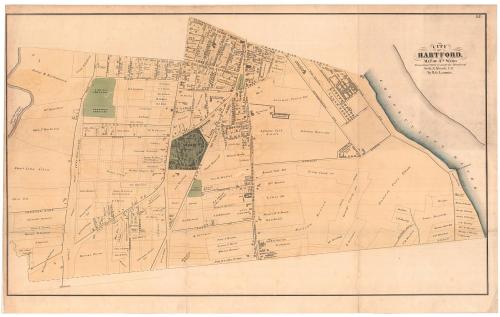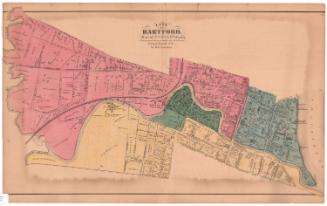City of Hartford, Map of 4th Ward
SurveyorSurveyed by
Hiram G. Loomis
(American, 1834 - 1911)
SurveyorSurveyed by
Seth E. Marsh
(American, about 1823 - 1878)
PublisherPublished by
Baker & Tilden
(founded 1869)
Date1869
MediumLithograph; black printer's ink and watercolor on wove paper, lined with paper
DimensionsPrimary Dimensions (image height x width): 21 1/2 x 36 5/8in. (54.6 x 93cm)
Sheet (height x width): 23 1/2 x 37 3/4in. (59.7 x 95.9cm)
Mount (height x width): 23 1/2 x 37 3/4in. (59.7 x 95.9cm)
ClassificationsGraphics
Credit LineConnecticut Museum of Culture and History collection
Object number2012.312.160
DescriptionMap of the Fourth Ward of Hartford, Connecticut, from Charter Oak Avenue to the north, the Connecticut River to the east, Bond Street to the south, and the South Fork of the Park River to the west. Streets are labeled, and land lots are denoted and include the names of some lot owners as well as the location and general shape of buildings on the lots. Notable landowners include Solomon Porter and Samuel Colt. Colt's Fire Arms Manufactory is located in the northeast corner. Parks and green spaces include Zion Hill Cemetery, Barnard's Cemetery, the old cemetery and South park. In the center of the ward is the space that housed the Retreat for the Insane (now the Institute of Living at Hartford Hospital), two bowling alleys, and a museum. The Hartford and Wethersfield Horse Railroad runs north-south through the ward.
Label TextBaker & Tilden's Atlas of Hartford City and County was published in Hartford in 1869. It is an early example of a city atlas, providing detailed maps of the different areas of a city, such as this one, showing Hartford's Fourth Ward, which included both the Colt Firearms Manufactory complex, the Colt mansion and grounds, and the Retreat for the Insane, Hartford's insane asylum. The rather messy hand-coloring was apparently done without the aid of stencils, often used for coloring maps, since the colors are unevenly applied and fail to stay within the outlines.
NotesCartographic Note: No scaleStatus
Not on view










